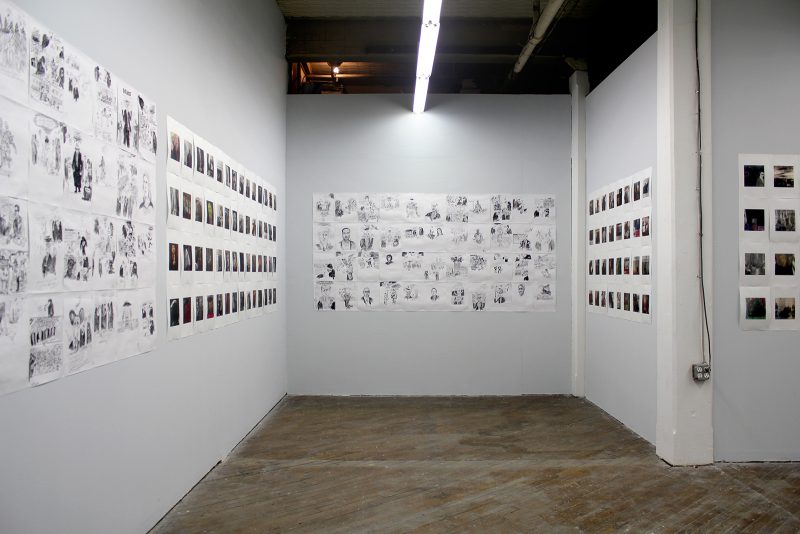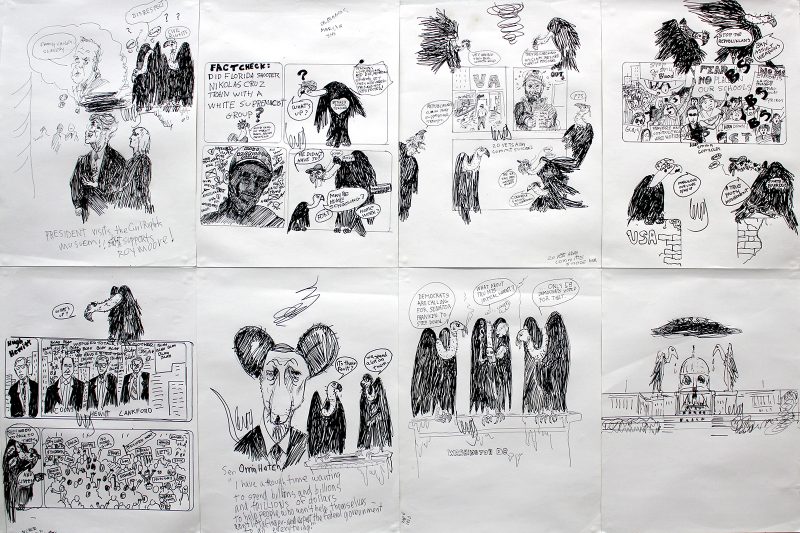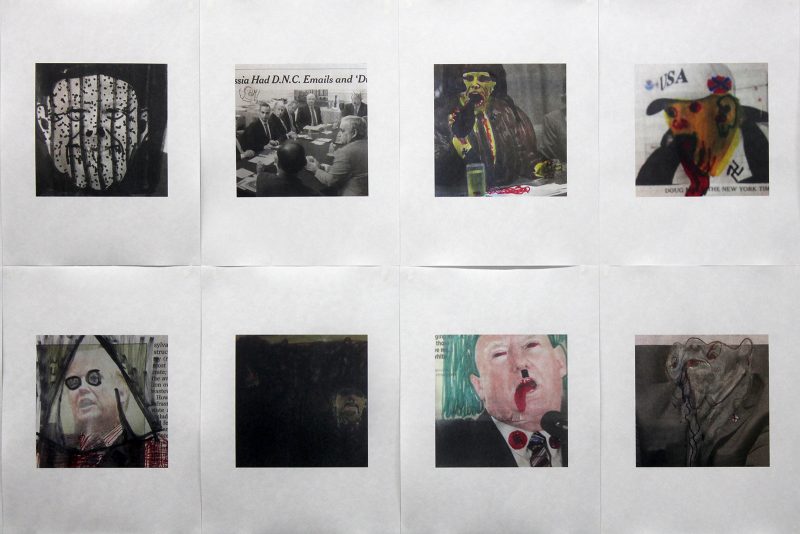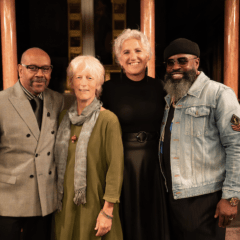Derisive, diminutively-endowed statues in the nude, performative jailings, sex toys, protest signs and paintings of all shapes and sizes; the running list of Trump-themed art and ephemera is a never ending, often navel-gazing source of amusement for artists united in opposition.
A lot of anti-Trump art is built on simple foundations:
- Make fun of Trump’s face and/or body. It’s hard for many to resist cheap shots at his day-glo skin, puckered mouth, and obesity.
- Take something/anything offensive or icky, and make it Trump-like.
The former method is particularly irritating because it descends into lookism with no compunctions. At best, it’s simple and self-indulgent — at worst, it reaffirms the medieval notion that we ought to equate aesthetic beauty with moral good. Though tethered to a rather robotic equation of A + B = C, the latter can lead to more complicated and interesting results; the inflatable Trump rat initially appears a one-liner, but is a witty appropriation (or expansion) of union protest culture.
I don’t mean to come down so hard on artists who make these pieces. It’s cathartic, and on the macro-scale, all works about Trump are valuable in their ability to keep us angry, attentive and entertained. Still, it’s notable that many Trump artworks run parallel in function and complexity with mass-produced gag gifts: after the artist-designed Donald Trump butt plug, indulge in a Trump themed novelty toilet paper roll from Amazon. In both cases, someone is making a quick buck.
The big business of painting Trump
For me, this transactional nature decreases a Trump-themed artwork’s tastefulness proportionally to its increase in price — though there are exceptions. I find Judith Bernstein’s Money Shot paintings unpretentious, brutal and hilarious. Their humor is crass, uncomfortably absurd, over-the-top. These paintings are weird. Fundamentally, they’re successful because they’re about more than Trump — Bernstein takes a shot at “schlongfaces” everywhere.

But mostly, expensive Trump paintings miss the mark. Though Barnaby Furnas is one of my favorite painters, I found the Trump paintings in his recent show Frontier Ballads (at Marianne Boesky) totally tone deaf. A blue-chip white cube is a horrible setting for protest art — and though Furnas is known for massive, sublimely-scaled paintings with incredibly gory syringe-sprayed ‘blood,’ the two Trump paintings in this show are bizarrely vanilla. In both, Trump stands as an oversized, geometric figure in front of a crowd. In one of them, his toupee is aflame, set alight by tiny aircraft, but even this act of violence is made less significant by the big smile plastered on his face. The press release for that show doesn’t even mention Trump or his policies, but spends an entire paragraph fetishizing Furnas’s use of fancy, expensive robotics in the studio. Though written by the gallery and not indicative of Furnas’s personal position, this press release makes obvious the disconnect between the representation of politics through painting, and the lived realities of people affected by those politics.
Hometown heroes take on the administration
In the deluge of Trump art since November of 2016, it’s exciting to see Trump projects by Philadelphia artists that don’t trip into these pitfalls. In #NOTMYPRESIDENT at Marginal Utility, work by Sarah McEneaney and LeRoy Johnson is a welcome reminder of the power of art and its potential as a form of activism. The artists, both Pew Fellows, are local behemoths; McEneaney has shown her paintings all across the country (recently in a two-person exhibit in LA), and Johnson’s intimate sculptures of the Philadelphia landscape have earned him numerous grants and exhibitions (including at the University City Arts League in 2016). Something I admire: unlike many artists, the work in this show is not a diversion of their respective practices to follow a contemporary trend. Rather, it consists of their small but tenacious acts of resistance while maintaining the consistent threads of their respective artistic careers.
The show consists of hundreds of drawings tacked up in grids. Johnson’s drawings are on sheets of printer or sketchbook paper, a speedy scrawl carried out in ballpoint pen. Each loosely follows a comic-like format, with speech bubbles, text, and sometimes rectangles denoting separate scenes. Every page signifies the news of a different day, a funny and intimate kind of reaction to these macro events. Overarching characters and wordplay of Johnson’s creation populate these drawings, providing humorous commentary. Two birds (vultures instead of eagles) act as commentators, wheezily remarking on the idiocy of contemporary politics; Republicans become “REPUBLIKLANS.”

There’s a Goya-esque discontent that filters through these drawings. Looking at them, I’m totally amazed by how comprehensively they document the past year and a half of the Trump administration. Reading through them is like entering a time machine — it’s impossible for me to remember all the hirings and firings, but Johnson’s drawings render these events with droll wit. My favorite: on the bottom half of the page, three rats in suits (labelled McConnell, Sessions and Ryan) gesture their vote for cuts to Social Security, Medicare, food aid, housing, education, privacy, choice, wages, immigration, and more. Over their heads is a swarm of skulls, swastikas, and lies. Vultures preside over the sad scene, saying: “HMM, AMERICA DOESN’T LOOK SO GREAT!” … “THE FOUR HORSEMEN” … “WHERE’S THE FOURTH?” … “MAR A LAGO.”
Drawing against icons
McEneaney’s project is presented a little differently, because she hasn’t been physically saving her drawings. Since Trump was elected, she has been drawing overtop newspaper photographs and posting a snapshot on instagram; the original newspaper drawing gets trashed. For #WEHAVENOPRESIDENT, her square photographs have been printed on 8.5×11 sheets of paper, and displayed in the same grids as Johnson’s drawings. I love how McEneaney approaches Trump with the opposite strategy of most — instead of emphasizing Trump’s appearance (which solidifies his iconographic power), McEneaney prefers iconoclasm. She obliterates, scribbles, defaces — her President Trump (referred to as “resident rump” after meeting her marker) is most often a shadowy figure, a grotesque, devilish monster, or a red-eyed Hitler.

Sections of the room are directly related to phases in the news cycle. One wall is covered in depictions of Trump with an extendable, oversized pussy-grabbing claw — according to these drawings, his victim of choice is Melania, though he doesn’t seem to discriminate. In covering up his body, McEneaney reveals that all Trump’s sordid villainy is never properly expressed in the original photographs.
Staying engaged
Something that sets both artists apart from the others I have mentioned is their dedication to projects with real consistency and rigor. These are not one-off spectacles, but daily drawing projects that exist as personal reactions to a circus-like administration — as a way for both artists to stay engaged, and to engage others. In a really obvious and necessary way, they are doing exactly what artists can in the face of this kind of political climate — use their creativity as activism. Instagram, that platform so heavily used by artists, is exploited here not for personal gain, but for rallying “the opposition” with images that require thought. #NOTMYPRESIDENT proposes that we keep thinking, reading, and reacting. The tenacity of these projects answers the question: What happens after the protests, now that we’ve stopped referring to the new normal as the “new normal”?
#WEHAVENOPRESIDENT at Marginal Utility continues through May 13th, 2018.









